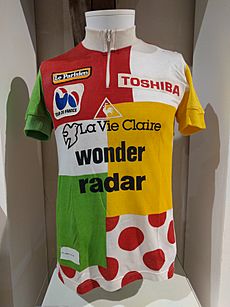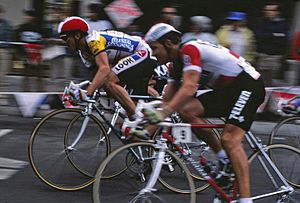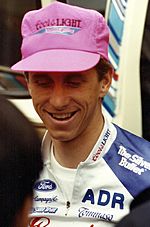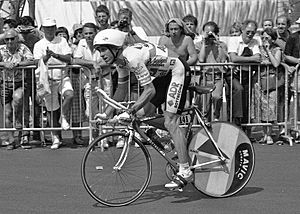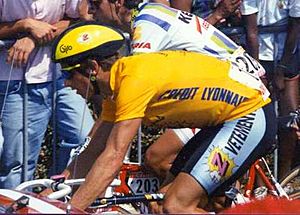Greg LeMond facts for kids
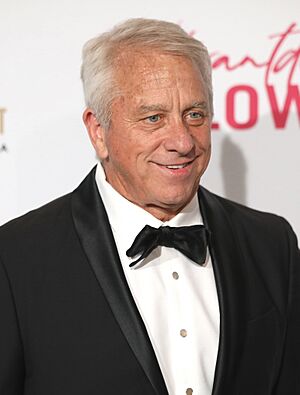
LeMond in 2024
|
|||
| Personal information | |||
|---|---|---|---|
| Full name | Gregory James LeMond | ||
| Nickname | L'Americain (The American) LeMonster |
||
| Born | June 26, 1961 Lakewood, California, U.S. |
||
| Height | 1.78 m (5 ft 10 in) | ||
| Weight | 67 kg (148 lb; 10 st 8 lb) | ||
| Team information | |||
| Current team | Retired | ||
| Discipline | Road | ||
| Role | Rider | ||
| Rider type | All-rounder | ||
| Major wins | |||
|
|||
Gregory James LeMond (born June 26, 1961) is a famous American former road racing cyclist. He made history by winning the Tour de France three times. He also won the Road Race World Championship twice. He is the only American man to ever win the Tour de France.
LeMond started his professional cycling journey in 1981. Just two years later, he became the first American male cyclist to win the Road World Championship. In 1986, he won the Tour de France, becoming the first non-European professional to win the men's Tour. In 1987, LeMond was seriously injured in a hunting accident. He missed the next two Tours while recovering.
At the 1989 Tour, LeMond made an amazing comeback. He won the race in a very exciting way on the final stage. He won the Tour again the next year, in 1990. This made him one of only nine riders to win three or more Tours. LeMond stopped competing in December 1994. He was honored in the United States Bicycling Hall of Fame in 1996. He was also the first professional cyclist to sign a contract worth a million dollars. He was the first cyclist to appear on the cover of Sports Illustrated magazine.
During his career, LeMond helped bring new technology to cycling. This included special aerodynamic handlebars and carbon fiber bicycle frames. He later sold these through his company, LeMond Bicycles. LeMond also had other businesses like restaurants and fitness equipment. He has always spoken out against athletes using performance-enhancing drugs in cycling. He is also a founding board member of 1in6, a charity that helps male victims of childhood abuse.
Contents
Early Life and Cycling Start
Greg LeMond was born on June 26, 1961, in Lakewood, California. He grew up in the Washoe Valley in Nevada. This area was ranch country, perfect for outdoor activities. Greg loved hiking, hunting, skiing, and fishing as a boy. He felt that these activities helped him focus. He later realized he had attention deficit hyperactivity disorder (ADHD). Cycling helped him a lot with this.
Greg went to Earl Wooster High School in Reno. He often rode his bike to school. His journey included riding over Mt. Rose.
How Greg Discovered Cycling
Greg started cycling in 1975. A famous skier named Wayne Wong suggested it. He said cycling was great for off-season training. Greg began competing the next year. He won his first 11 races in the Intermediate category (ages 13–15). Because he was so good, he was allowed to race against older Junior competitors (ages 16–19).
In 1977, at age 15, Greg finished second in the Tour of Fresno. He raced against John Howard, who was then the top U.S. road cyclist. Greg caught the eye of Eddie Borysewicz, the US Cycling Federation's national team coach. Eddie called Greg "a diamond, a clear diamond."
Junior World Champion
LeMond represented the United States at the 1978 Junior World Championships. He finished ninth in the road race. In 1979, at the Junior World Championships in Argentina, he won gold, silver, and bronze medals. His biggest win was in the road race.
At 18, LeMond was chosen for the 1980 U.S. Olympic cycling team. He was the youngest ever to make the team. However, the U.S. decided to boycott the 1980 Summer Olympics in Moscow. This meant Greg could not compete there.
Greg joined the U.S. National cycling team for a European racing trip in 1980. He finished third in the Circuit des Ardennes. Then he won the Circuit de la Sarthe stage race in France. This made him the first American and youngest rider to win a major pro-am event in Europe. This victory got him noticed by Cyrille Guimard, a team director for Renault. Guimard offered Greg a professional contract for 1981. Greg signed with Renault in Paris.
Professional Cycling Career
Greg LeMond was a very talented amateur rider. He quickly became one of the best professional cyclists. Many experts called him fuoriclasse, which means "in a class of his own."
Early Professional Success (1981–1983)
LeMond's first professional win came in 1981. He won a stage of the French Tour de l'Oise. He then won the Coors Classic in the United States. A big step for him was finishing third in the Critérium du Dauphiné Libéré. He was helping his team leader, Bernard Hinault, in that race. Greg won five races in his first year as a pro.
In 1982, LeMond broke his collarbone. This injury affected his racing schedule. He still competed in the World Championships in England. He finished second in the men's road race. He was the first American pro to win a medal at the World Championships since 1912.
Two weeks later, in September 1982, LeMond won the Tour de l'Avenir. This was a tough 12-day race in the mountains. He won by a record 10 minutes and 18 seconds. This huge win showed everyone in Europe that LeMond was truly special.
In 1983, LeMond won the Road World Championship in Switzerland. He became the first American male cyclist to win this title. Greg's skills, like his strength, climbing ability, and fast time trials, made him a great fit for big races like the Grand Tours.
Grand Tour Challenges (1984–1986)
LeMond rode his first Tour de France in 1984. He finished third, supporting his team leader Laurent Fignon. He also won the white jersey for the best young rider. The next year, 1985, he joined the La Vie Claire team. His job was to help Bernard Hinault win his fifth Tour.
During the 1985 Tour, Hinault had a crash and struggled. It became clear that LeMond was strong enough to win the Tour himself. On a tough mountain stage, LeMond was told by his team not to attack. He was frustrated because he felt he could have gained time. Hinault won the 1985 Tour, with LeMond finishing second. LeMond had helped Hinault win. In return, Hinault promised to help LeMond win the Tour the next year.
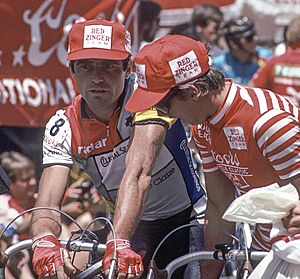
In the World Championships road race, LeMond finished second. He helped his American teammates, but in the end, a 38-year-old rider named Joop Zoetemelk made a surprise attack and won. LeMond took the silver medal.
For the 1986 Tour, LeMond and Hinault were co-leaders of the La Vie Claire team. Hinault seemed less sure about helping LeMond. He wanted to see who was stronger. Hinault attacked early in the race and gained a big lead. He said he was trying to make other rivals tired, but these attacks were not planned with LeMond.
On Stage 13, LeMond gained back a lot of time on Hinault. On Stage 17, LeMond took the yellow jersey as race leader. This was the first time an American wore it. The next day, LeMond and Hinault rode together up the famous Alpe d'Huez. LeMond let Hinault win the stage as a sign of unity. But the team had many disagreements. LeMond kept the yellow jersey and won his first Tour. He felt betrayed by Hinault and the team. LeMond later said the 1986 Tour was the hardest race of his career.
Hunting Accident and Recovery (1987–1988)
LeMond planned to defend his Tour title in 1987. But he broke his left wrist in a spring race. While recovering, he went turkey hunting in California. He was accidentally shot by his brother-in-law. About 60 pellets hit his back and right side. His injuries were very serious. He lost a lot of blood and almost died.
He had emergency surgery that saved his life. Four months later, he needed another surgery for a problem caused by the shooting. He missed the Tour de France in both 1987 and 1988. He tried to return to racing in 1988, but he had more health issues. He also found out about doping on his team, PDM. This led him to join a new team, ADR, in Belgium.
Amazing Comeback (1989)
After struggling in early 1989, LeMond thought about retiring. He started the 1989 Giro d'Italia to prepare for the Tour. He surprised everyone by finishing second in a time trial there. This showed he was getting stronger.
When the 1989 Tour de France began, no one expected LeMond to win. He hoped to finish in the top 20. But he rode very well from the start. He won a time trial on Stage 5 and took the yellow jersey. He lost the lead to his old rival, Laurent Fignon, on Stage 10. Then LeMond got it back on Stage 15. The lead went back and forth. Fignon had a 50-second lead over LeMond before the final stage.
The last stage was a 24.5 km individual time trial in Paris. It seemed impossible for LeMond to make up 50 seconds. But LeMond had used a wind tunnel to improve his riding position. He used special aerodynamic handlebars and a helmet. Fignon did not use these. LeMond rode incredibly fast. He beat Fignon by only eight seconds to win his second Tour de France! This was the closest finish in Tour history.
The press called it "the most astonishing victory in Tour de France history." LeMond said it felt "much more satisfying" than his first win.
LeMond's amazing year continued. On August 27, he won the World Championships road race in France. He was only the fifth person in history to win both the Tour de France and the World Championship in the same year. In December, Sports Illustrated named LeMond its 1989 "Sportsman of the Year." He was the first cyclist to receive this honor.
Third Tour Victory (1990)
After his 1989 success, LeMond signed a huge $5.5 million contract with the French team "Z." This was the richest contract in cycling history at the time. He entered the 1990 Tour de France as the defending champion. His team was very strong.
A teammate, Ronan Pensec, surprisingly held the yellow jersey for many days. LeMond could not challenge for the lead until his teammate lost it. LeMond finally took the yellow jersey from Claudio Chiappucci on the final individual time trial. He won the 1990 Tour without winning any individual stages. LeMond is the last rider to win the Tour while wearing the world champion jersey. His 1990 win made him one of only eight cyclists to win three or more Tours.
Later Career and Retirement (1991–1994)
LeMond felt confident before the 1991 Tour de France. He was the defending champion. He even wore the yellow jersey for a few days. But he struggled in the mountains and finished seventh overall.
In 1992, LeMond won the Tour DuPont. This was his last major win. He also had a strong finish in Paris–Roubaix. He never won any of cycling's 'Monument' races, but he had high finishes in several of them.
In the 1992 Tour de France, LeMond started well but then lost a lot of time in the mountains. He had to leave the race. He tried to train hard, but his performance did not improve. He had to leave the 1993 Giro d'Italia and could not enter the 1993 Tour de France.
LeMond started the 1994 Tour de France but had to abandon after the first week. In December, he announced his retirement. He later said that the increasing use of doping in cycling made it hard for him to compete. He felt that something had changed in the sport. He was inducted into the United States Bicycling Hall of Fame in 1996.
Business Ventures
LeMond was a leader in using carbon fiber bicycle frames. His 1986 Tour de France win was the first for a carbon-framed bike. He also won his 1989 and 1990 Tours on carbon fiber frames. These bikes had "Greg LeMond" on them.
LeMond Bicycles
In 1990, LeMond started LeMond Bicycles. He wanted to make bikes for himself and for others to buy. In 1995, he partnered with Trek Bicycle Corporation. Trek would make and sell bikes designed by LeMond under his brand. This partnership lasted 13 years.
However, LeMond and Trek had disagreements. LeMond spoke out against doping in cycling. He was concerned about the relationship between a doping doctor and Trek's star athlete, Lance Armstrong. Trek pressured LeMond to apologize. LeMond later said Armstrong tried to hurt his relationship with Trek. In 2008, Trek stopped making LeMond Bicycles. After a legal dispute, LeMond got full control of his brand name in 2010.
Other Businesses
In 2002, LeMond helped start LeMond Fitness, Inc. This company makes bicycle trainers and exercise bikes. LeMond is the chairman of the board. He also partnered with the French company Time to make and sell bicycles.
LeMond also invested in real estate. He joined partners to invest in the Yellowstone Club, a private ski and golf community in Montana. He later settled a lawsuit related to this investment.
In 1990, LeMond opened a restaurant called Scott Kee's Tour de France. He also partnered in several Bruegger's bagel bakery–café franchises.
In 2016, LeMond founded LeMond Composites. This company makes carbon fiber materials. In 2017, he moved his family to Tennessee to be near the manufacturing facility.
Broadcasting and Personal Life
In 2014, LeMond joined Eurosport as a cycling expert. He provided analysis for races like the Tour de France until 2017.
LeMond is married to Kathy Morris. They have three children: Geoffrey, Scott, and Simone. They lived in Minnesota for many years before moving to Tennessee. Since retiring, LeMond has supported charities. He is a founding board member of 1in6.org, which helps men who have experienced childhood abuse.
LeMond loves the outdoors and fly fishing. In 1991, he set a world record for catching a four-pound smallmouth bass while fly fishing. He often took his fishing gear to bike events.
After cycling, LeMond competed in Formula Ford 2000 auto racing. He also works as a motivational speaker. In 2008, he narrated a documentary for Adventures for the Cure.
In 2007, LeMond rode a cycling event called L'Étape du Tour. He said it was a great experience. He also spoke out more about doping in cycling. He became a witness in a doping case.
On January 30, 2013, LeMond was in a car accident. He suffered a concussion and a back injury. He made a full recovery.
On September 19, 2019, the United States House of Representatives passed a bill to give LeMond the Congressional Gold Medal. This award recognizes his service as an athlete, activist, and role model. The bill was approved by Congress in November 2020 and signed by President Donald Trump in December. LeMond received the medal on July 9, 2025.
In June 2022, LeMond was diagnosed with non-life-threatening leukemia.
Career Achievements
Major Results
- 1977
- 1st
Road race, National Junior Road Championships
- 1978
- 1st
 Overall Vuelta de Bisbee
Overall Vuelta de Bisbee - 2nd Road race, National Junior Road Championships
- 3rd
 Team time trial, UCI Junior Road World Championships
Team time trial, UCI Junior Road World Championships - 1979
- 1st
 Road race, UCI Junior Road World Championships
Road race, UCI Junior Road World Championships - 1st
Road race, National Junior Road Championships
- 1st Nevada City Classic
- 2nd
 Track pursuit, UCI Junior Track World Championships
Track pursuit, UCI Junior Track World Championships - 3rd
 Team time trial, UCI Junior Road World Championships
Team time trial, UCI Junior Road World Championships - 1980
- 1st
 Overall Circuit de la Sarthe
Overall Circuit de la Sarthe - 1st Nevada City Classic
- 3rd Overall Circuit des Ardennes
- 1981
- 1st
 Overall Coors Classic
Overall Coors Classic
- 1st Stages 1 & 7
- Tour de Picardie
- 1st Stages 2 & 2a
- 1st Nevada City Classic
- 3rd Overall Critérium du Dauphiné Libéré
- 3rd Overall Route du Sud
- 7th Overall Circuit de la Sarthe
- 1982
- 1st
 Overall Tour de l'Avenir
Overall Tour de l'Avenir
- 1st Stages 4 (ITT), 5 & 8 (ITT)
- 2nd
 Road race, UCI Road World Championships
Road race, UCI Road World Championships - 2nd Overall Tour Méditerranéen
- 3rd Overall Tirreno–Adriatico
- 1st Stage 3
- 3rd Overall Tour de Corse
- 3rd Grand Prix de Rennes
- 1983
- 1st
 Road race, UCI Road World Championships
Road race, UCI Road World Championships - 1st
 Overall Critérium du Dauphiné Libéré
Overall Critérium du Dauphiné Libéré
- 1st Stages 1, 5 & 7b (ITT)
- 1st Overall Super Prestige Pernod International
- 1st Critérium des As
- 1st Stage 1 Tour Méditerranéen
- 2nd Grand Prix des Nations
- 2nd Giro di Lombardia
- 4th Overall Tour de Suisse
- 4th Paris–Tours
- 6th Druivenkoers Overijse
- 10th Overall Tirreno–Adriatico
- 1984
- 1st Stage 1 Clásico RCN
- 3rd Overall Tour de France
- 3rd Overall Critérium du Dauphiné Libéré
- 1st Stage 7b
- 3rd Liège–Bastogne–Liège
- 5th Overall Tirreno–Adriatico
- 7th Overall Ronde van Nederland
- 8th Overall Critérium International
- 9th Gent–Wevelgem
- 1985
- 1st
 Overall Coors Classic
Overall Coors Classic
- 1st Stage 5
- 2nd Overall Tour de France
- 2nd
 Road race, UCI Road World Championships
Road race, UCI Road World Championships - 2nd Overall Tour of the Basque Country
- 3rd Overall Giro d'Italia
- 3rd Super Prestige Pernod International
- 4th Overall Critérium International
- 4th Paris–Roubaix
- 4th Omloop Het Volk
- 6th Overall Tour Méditerranéen
- 7th Tour of Flanders
- 7th Grand Prix Eddy Merckx
- 1986
- 1st
 Overall Tour de France
Overall Tour de France
- 1st Stage 4 Volta a la Comunitat Valenciana
- 2nd Milan–San Remo
- 2nd Super Prestige Pernod International
- 2nd Overall Coors Classic
- 1st Stage 4a
- 3rd Overall Paris–Nice
- 3rd Overall Tour de Suisse
- 3rd Overall Critérium International
- 4th Overall Giro d'Italia
- 1st Stage 5
- 4th La Flèche Wallonne
- 4th Züri-Metzgete
- 7th Overall Étoile de Bessèges
- 7th Road race, UCI Road World Championships
- 1989
- 1st
 Road race, UCI Road World Championships
Road race, UCI Road World Championships - 1st
 Overall Tour de France
Overall Tour de France
- 1st Stages 5 (ITT), 19 & 21 (ITT)
- 2nd Boucles de l'Aulne
- 4th Overall Critérium International
- 4th Grand Prix des Amériques
- 6th Overall Tirreno–Adriatico
- 1990
- 1st
 Overall Tour de France
Overall Tour de France - 2nd Züri-Metzgete
- 3rd Boucles de l'Aulne
- 4th Road race, UCI Road World Championships
- 10th Overall Tour de Suisse
- 1991
- 7th Overall Tour de France
Grand Tour Results
| Grand Tour | 1983 | 1984 | 1985 | 1986 | 1987 | 1988 | 1989 | 1990 | 1991 | 1992 | 1993 | 1994 |
|---|---|---|---|---|---|---|---|---|---|---|---|---|
| DNF | — | — | — | — | — | — | — | — | — | — | — | |
| — | — | 3 | 4 | — | DNF | 39 | 105 | DNF | — | DNF | — | |
| — | 3 | 2 | 1 | — | — | 1 | 1 | 7 | DNF | — | DNF |
Classic Race Results
| Monument | 1981 | 1982 | 1983 | 1984 | 1985 | 1986 | 1987 | 1988 | 1989 | 1990 | 1991 | 1992 | 1993 | 1994 |
|---|---|---|---|---|---|---|---|---|---|---|---|---|---|---|
| Milan–San Remo | — | 17 | 30 | — | — | 2 | — | — | — | — | — | 22 | — | 140 |
| Tour of Flanders | — | — | — | 15 | 7 | 11 | — | 30 | 63 | — | — | — | 25 | — |
| Paris–Roubaix | — | — | — | — | 4 | 30 | — | — | — | — | 55 | 9 | — | — |
| Liège–Bastogne–Liège | — | — | 78 | 3 | 17 | 14 | — | — | — | — | — | — | — | — |
| Giro di Lombardia | — | — | 2 | — | — | — | — | — | — | — | — | — | — | — |
| World Championships | 1981 | 1982 | 1983 | 1984 | 1985 | 1986 | 1987 | 1988 | 1989 | 1990 | 1991 | 1992 | 1993 | 1994 |
| 47 | 2 | 1 | 27 | 2 | 7 | — | — | 1 | 4 | DNF | — | — | — |
| — | Did not compete |
|---|---|
| DNF | Did not finish |
Awards
- Sports Illustrated Sportsman of the Year: 1989
- Jesse Owens International Trophy: 1991
- Korbel Lifetime Achievement Award: 1992
Images for kids
See also
 In Spanish: Greg LeMond para niños
In Spanish: Greg LeMond para niños


